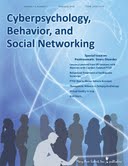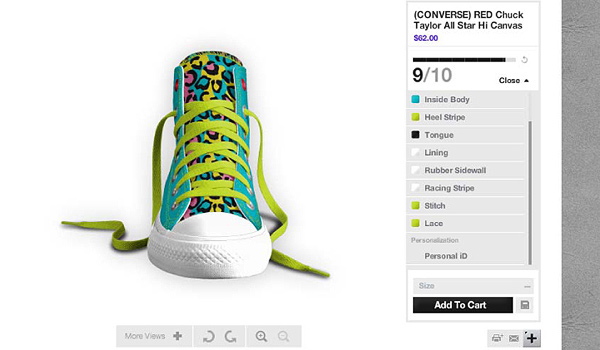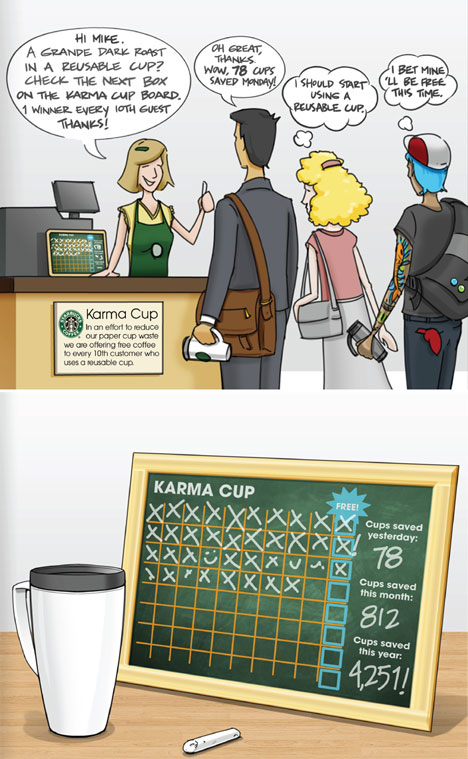Design a Shoe to Create a Specific Think-and-Feel
June 19th, 2010Converse has set up a mass customization capability for their shoes. Working from their website you can design your own shoe and get one or more pairs in just 4-6 weeks. You can control shoe type and color/print on many parts of the shoe including toe, outside body, sole, lace, tongue, stitching and so on. You can even add text.
There is enough flexibility to create some truly distinctive effects. For cognitive designers, this could be an opportunity to test ideas about how to create a specific think-and-feel via shoe designs. For example, can you design shoes that would cause people to reminisce, give thanks, feel centered or experience other specific mental states? Try it out. If you do try it out be sure to share your results. I am especially interested in thoughts on how to link shoe parts to color/patterns to generate specific thoughts and feelings.
Will the Karma Cup Change Behavior?
June 18th, 2010Core77 has a post on the results of the betacup competition. A $20,000 open innovation design contest to develop a way to eliminate paper coffee cup waste. According to the post we generate some 58 million cups a year which tend to end up in landfills. The goal is to design something to change our behavior from using paper coffee cups to doing something else that still gives us coffee but avoids the environmental impact. The tag line is to drink sustainably.
The winner is the Karma Cup - “A chalkboard sitting by the register. Every guest who uses a reusable mug marks the chalkboard. Every 10th guest receives a free item.”
A great example of an attempt to use ordinary materials to create extra ordinary behavior change. But will it work? From a cognitive design perspective do you expect the Karma cup to produce lasting behavior change in coffee drinkers?
Eyes Blink When Mind Wanders
June 17th, 2010 One of the major lessons learned about how the mind works over the last couple of decades is that it is fully dependent on the body. Cognition is embodied or at least partially determined by bodily actions, interactions and so-called “memories”. Talking with our hands, solving a problem by walking or pacing, moving to learn and so on. Now there is new evidence that we blink as an embodiment of day dreaming. The idea is that we blink to help shut out perceptual input that would otherwise require attention and interfere with our wandering mind. ScienceDaily has a nice summary of the study, Out of Mind, out of Sight: Blinking Eyes Indicate Mind Wandering. To quote:
One of the major lessons learned about how the mind works over the last couple of decades is that it is fully dependent on the body. Cognition is embodied or at least partially determined by bodily actions, interactions and so-called “memories”. Talking with our hands, solving a problem by walking or pacing, moving to learn and so on. Now there is new evidence that we blink as an embodiment of day dreaming. The idea is that we blink to help shut out perceptual input that would otherwise require attention and interfere with our wandering mind. ScienceDaily has a nice summary of the study, Out of Mind, out of Sight: Blinking Eyes Indicate Mind Wandering. To quote:
”What we suggest is that when you start to mind-wander, you start to gate the information even at the sensory endings — you basically close your eyelid so there’s less information coming into the brain,” says Smilek.
This is part of a shift in how scientists are thinking about the mind, he says. Psychologists are realizing that “you can’t think about these mental processes, like attention, separately from the fact that the individual’s brain is in a body, and the body’s acting in the world.” The mind doesn’t ignore the world all by itself; the eyelids help.”
Designs that support mind wandering can be important for stress management and creativity.
Sobriety That Sticks if You Put in 5 or More Years
June 14th, 2010 The Scientific American has an excellent article on Alcoholics Anonymous as it celebrates its 75th year. The article highlights success stats. Not surprising the ability to stay sober correlates to the number of meetings you attend and how long you stay with the program. To quote:
The Scientific American has an excellent article on Alcoholics Anonymous as it celebrates its 75th year. The article highlights success stats. Not surprising the ability to stay sober correlates to the number of meetings you attend and how long you stay with the program. To quote:
”Of those who dropped out of A.A. after the first year, only 43 percent were still sober at year five. Of those who went to 60 meetings a year 73 percent continued to abstain. And 79 percent of those who attended 200 meetings annually had gone into remission by year five. Maybe most surprising, is that 61% of those who attended 200 meetings in their first year but dropped down to six meetings in year five, were still able to stay dry.”
Staying sober is a powerful behavior change. AA’s 12 guiding principles warrant serious study by cognitive designers working in any area of behavior change.
Is Math Anxiety Contagious?
June 13th, 2010 I hate math. Google that phrase and you will find a large number of groups, sites, books, articles, posts and images that celebrate the hatred of mathematics in the US. The obvious cause of this is that we teach (or try to teach) a lot of math to many students in the US. It is required. For most people math (or the way it is taught) does not fit how their minds naturally work. There is a strong mismatch between how we think and mathematical reasoning. Forcing it, in public, for a grade leads to negative and sometimes even traumatic experiences and ultimately anxiety. Such anxiety is why we hate math.
I hate math. Google that phrase and you will find a large number of groups, sites, books, articles, posts and images that celebrate the hatred of mathematics in the US. The obvious cause of this is that we teach (or try to teach) a lot of math to many students in the US. It is required. For most people math (or the way it is taught) does not fit how their minds naturally work. There is a strong mismatch between how we think and mathematical reasoning. Forcing it, in public, for a grade leads to negative and sometimes even traumatic experiences and ultimately anxiety. Such anxiety is why we hate math.
Resolving math anxiety is definitely a cognitive design problem (one of the more important ones) so I am always on the look out for new scientific studies that provide designable insights into it.
Take for example the interesting post on the BrainBlogger, Female Teachers’ Math Anxiety Effects Female Students, that suggests math anxiety might be contagious. To quote:
”A new study done on elementary school children suggests that a female teacher’s attitude to mathematics affects the performance of her female students. In the study, the more anxious teachers were about math, the lower the math achievement of female students. Moreover, girls who believed in traditional gender ability beliefs such as “boys are good at math and girls are good at reading,” had significantly lower achievement in math at the end of the school year than girls who did not and boys overall. This relationship between the teachers math anxiety and students performance was absent at the beginning of the school year when teachers did not have ample time with the students to affect their performance. It was evident only at the end of the school year. Thus, teachers with high math anxiety specifically affect girls’ math achievement, by influencing girls’ gender-related beliefs about who is good at math.”
Given that females teach most of the elementary school math in the US this could be an important source of the problem. As the author states later in the post “more care needs to be taken to develop positive math attitudes in these educators.” I agree. But exactly how do we do that? Can we leverage anxiety into empathy?
For the record, I do not hate math.
Sugar, Self-Control and Mental Energy
June 12th, 2010 Our brain consumes 20-30% of our total energy (25% of glucose, 20% oxygen). It burns energy 10 times faster per unit of tissue than any other part of the body. Energy plays a big role in brain function and cognitive performance. The makeup of this energy is complex. There is brain glucose, a number of neurotransmitters, adrenaline and more psychological components such as feeling of mental fatigue and the ability to do cognitive work. As designers we need to be concerned with how the features and functions of an artifact impact all aspects of mental energy. So I am always on the lookout for new scientific studies that provide insight into how to leverage mental energy with design.
Our brain consumes 20-30% of our total energy (25% of glucose, 20% oxygen). It burns energy 10 times faster per unit of tissue than any other part of the body. Energy plays a big role in brain function and cognitive performance. The makeup of this energy is complex. There is brain glucose, a number of neurotransmitters, adrenaline and more psychological components such as feeling of mental fatigue and the ability to do cognitive work. As designers we need to be concerned with how the features and functions of an artifact impact all aspects of mental energy. So I am always on the lookout for new scientific studies that provide insight into how to leverage mental energy with design.
A good example is recent work at the University of Pennsylvania, nicely summarized by EurekaAlert!, that provides some evidence against the glucose depletion theory of self-control. To quote:
 “Kurzban’s new analysis is consistent with the neuroscience literature, which strongly implies that the marginal difference in glucose consumption by the brain from five minutes of performing a “self-control” task is unlikely in the extreme to be of any significant size. Further, research on exercise shows that burning calories through physical activity, which really does consume substantial amounts of glucose, in fact shows the reverse pattern from what the model would predict: People who have recently exercised and burned glucose are better, not worse, on the sorts of tasks used in the self-control literature.”
“Kurzban’s new analysis is consistent with the neuroscience literature, which strongly implies that the marginal difference in glucose consumption by the brain from five minutes of performing a “self-control” task is unlikely in the extreme to be of any significant size. Further, research on exercise shows that burning calories through physical activity, which really does consume substantial amounts of glucose, in fact shows the reverse pattern from what the model would predict: People who have recently exercised and burned glucose are better, not worse, on the sorts of tasks used in the self-control literature.”
This means that designs aimed at boosting blood sugar levels to improve self-control may not work. It also suggest that using activity or exercise may work (likely due to the production of mental energy via neurotransmitters or increased in self-efficacy and other psychological effects).
In general this implies that cognitive designs need to go beyond the biological effects of sugar to emphasize the production of natural brain drugs (neurotransmitters) and mental states that correlated to the psychological ability to do mental work (e.g. meaning).
$ Blunts Ability to Savor and Achieve Happiness
June 7th, 2010 Be sure to consider the new study, Money Giveth and Money Taketh Away: The Dual Effect of Wealth on Happiness. Key findings for cognitive designers include:
Be sure to consider the new study, Money Giveth and Money Taketh Away: The Dual Effect of Wealth on Happiness. Key findings for cognitive designers include:
- A correlation between wealth (or just the thought of wealth) and the ability to savor experiences
- The ability to savor predicts your degree of happiness
So wealth blunts our ability to savor and therefore undercuts the mechanism that is the source of most of our happiness.
Getting to the full article requires a subscription. If you don’t have one check out the recap of the study on the New Brain Blog.
Designs for Recapturing Trust
June 4th, 2010 Organizations are keen on creating and keeping trusting relationships with employees, customers, suppliers and other stakeholders. Trust makes everything far easier. Sometimes trust is damaged or lost so we need “trust recovery” processes. A good example is service recovery for customers that did not receive the appropriate experience. Psychological factors play the dominant role in trust. This means trust recovery processes are primarily a cognitive design challenge.
Organizations are keen on creating and keeping trusting relationships with employees, customers, suppliers and other stakeholders. Trust makes everything far easier. Sometimes trust is damaged or lost so we need “trust recovery” processes. A good example is service recovery for customers that did not receive the appropriate experience. Psychological factors play the dominant role in trust. This means trust recovery processes are primarily a cognitive design challenge.
So I am always on the look out for new scientific insights into the nature of trust that could be useful for designers. For example, How Implicit Beliefs Influence Trust, from the Wharton School of Business offers several designable insights.
“After a trust violation, some people are quick to forgive, whereas others never trust again. In this report, we identify a key characteristic that moderates trust recovery: implicit beliefs of moral character. Individuals who believe that moral character can change over time (incremental beliefs) are more likely to trust their counterpart following an apology and trustworthy behavior than are individuals who believe that moral character cannot change (entity beliefs). We demonstrate that a simple but powerful message can induce either entity or incremental beliefs about moral character.
Concerning the simple but powerful message:
“… targets who have incremental beliefs may be particularly receptive to trust-repair efforts that include a promise to change. In contrast, targets who have entity beliefs may be particularly receptive to trust-repair efforts that include denials or attempts to deflect blame.”
The bottom line – cognitive designers doing work in trust should include incremental/entity beliefs in any psychographic profile that is developed and tune the design accordingly.
CyberPsychology & Behavior
June 2nd, 2010 The journal Cyberpsychology, Behavior and Social Networking is an excellent resource for cognitive designers working on Internet applications of all types. High quality and readable articles reveal many designable insights and loads of psychographic information.
The journal Cyberpsychology, Behavior and Social Networking is an excellent resource for cognitive designers working on Internet applications of all types. High quality and readable articles reveal many designable insights and loads of psychographic information.
You can sample a free issues in December 2009 and February 2010. For examples of material relevant to cognitive design issues check out The Theory of Planned Behavior Applied to Young People’s Use of Social Networking Sites or The Attitudes, Feelings and Experiences of Online Gamers - A Qualitative Analysis.


